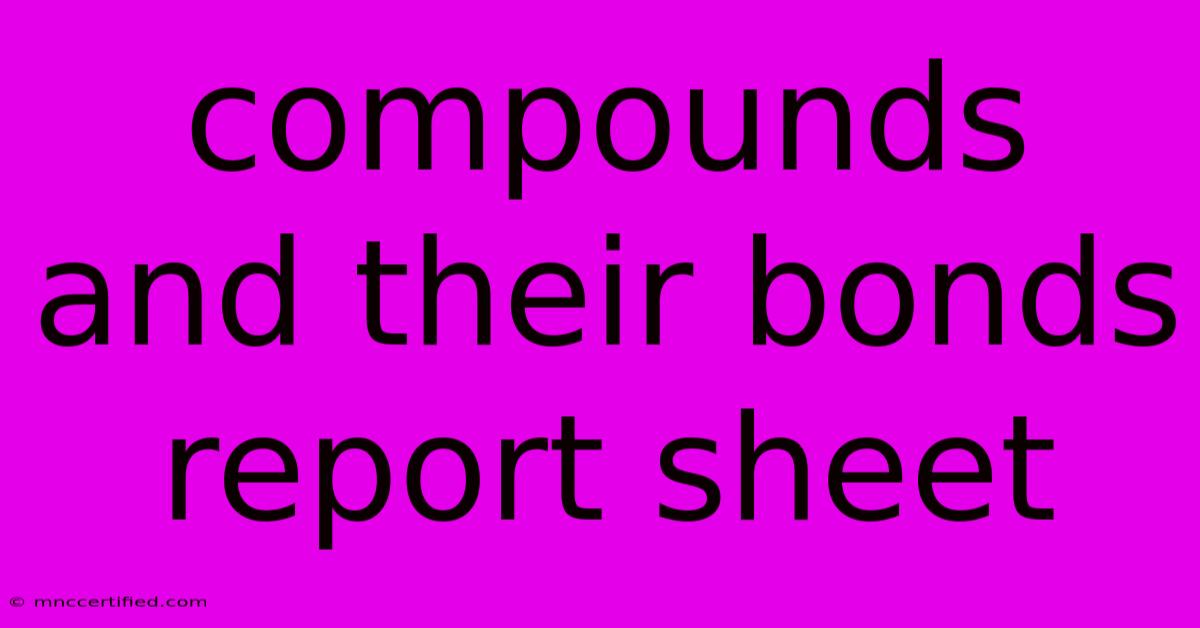Compounds And Their Bonds Report Sheet

Table of Contents
Demystifying Compounds and Their Bonds: A Comprehensive Report Sheet Guide
Understanding the world of chemistry often involves deciphering the intricate relationships between atoms, forming compounds through various bonds. This report sheet serves as your guide to unraveling these fundamental concepts.
1. Defining the Basics: Compounds and Bonds
Compounds are substances formed when two or more different elements chemically combine in a fixed ratio. These elements lose their individual properties and form a new substance with distinct characteristics.
Chemical bonds are the forces that hold atoms together in a compound. These forces arise from the interactions between electrons in the outermost shell of atoms, known as valence electrons.
Types of Chemical Bonds:
- Ionic Bonds: Formed by the electrostatic attraction between positively charged ions (cations) and negatively charged ions (anions).
- Covalent Bonds: Formed by the sharing of electrons between atoms. This sharing can be equal (nonpolar) or unequal (polar).
- Metallic Bonds: A type of bond found in metals, where electrons are delocalized and free to move throughout the metal lattice.
2. Key Concepts for Your Report Sheet:
- Lewis Structures: These diagrams represent the bonding between atoms in a compound using dots to represent valence electrons. Lewis structures help visualize the distribution of electrons and identify the types of bonds present.
- Molecular Geometry: The three-dimensional arrangement of atoms in a molecule. This geometry influences the molecule's properties, such as polarity and reactivity.
- Bond Polarity: The unequal sharing of electrons in a covalent bond creates a separation of charge, leading to a polar bond.
- Hybridization: The mixing of atomic orbitals to form new hybrid orbitals, leading to stronger and more stable bonds.
3. Sample Report Sheet Structure
I. Compound Information:
- Name of the compound: (e.g., Sodium Chloride, Water, Carbon Dioxide)
- Chemical Formula: (e.g., NaCl, H₂O, CO₂)
- Type of Bond: (e.g., Ionic, Covalent, Metallic)
- Bond Polarity: (e.g., Nonpolar, Polar)
II. Lewis Structure and Molecular Geometry:
- Draw the Lewis Structure: Include all valence electrons and bonding pairs.
- Determine the Molecular Geometry: Using VSEPR theory (Valence Shell Electron Pair Repulsion theory) to predict the shape of the molecule.
- Explain the Hybridization of Central Atom: If applicable, explain the hybridization scheme of the central atom in the molecule.
III. Properties and Applications:
- Physical Properties: Melting point, boiling point, solubility, conductivity.
- Chemical Properties: Reactivity, acidity, basicity.
- Applications: Where is this compound used? (e.g., Industrial processes, pharmaceuticals, everyday life)
IV. Additional Notes:
- Any interesting observations: Unique bonding characteristics, unusual properties, or notable applications.
- Challenges: Any difficulties encountered while completing the report.
4. Tips for Success
- Practice, practice, practice: The more examples you work through, the better you'll understand the concepts.
- Visual aids: Use models or online resources to visualize the structures of molecules.
- Collaborate: Discuss concepts with classmates or instructors.
- Connect with real-world applications: Explore how compounds are used in everyday life.
By following this guide, you'll be able to create a comprehensive report sheet that demonstrates your understanding of compounds and their bonds. Remember, chemistry is a journey of discovery, and this report sheet is just one step on the path to mastering this fascinating field!

Thank you for visiting our website wich cover about Compounds And Their Bonds Report Sheet. We hope the information provided has been useful to you. Feel free to contact us if you have any questions or need further assistance. See you next time and dont miss to bookmark.
Featured Posts
-
Dental Hygienist Malpractice Insurance
Nov 09, 2024
-
Free Streaming The Graham Norton Show Season 32 Online
Nov 09, 2024
-
Heretic Ending Explained Religions Flaw
Nov 09, 2024
-
Unc Mens Basketball Drops Game To Top Ranked Team
Nov 09, 2024
-
Dieticians Near Me That Take Insurance
Nov 09, 2024